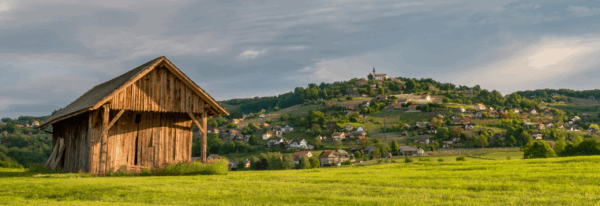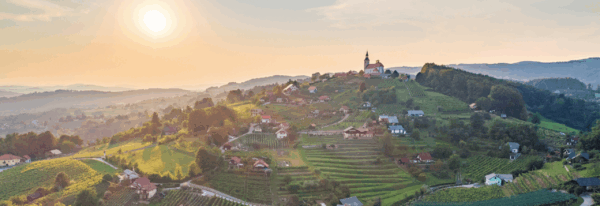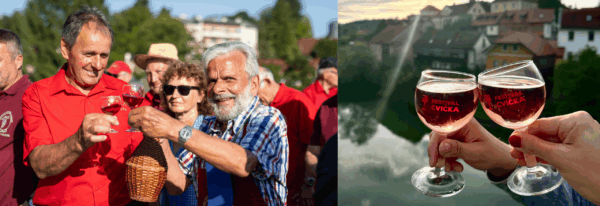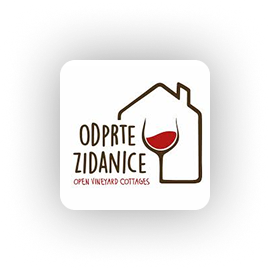Trška gora & cviček
Trška Gora

One of the Most Famous Wine Hills
Trška Gora (428 meters above sea level) is one of the most recognizable wine-growing hills in Slovenia, known for having the highest concentration of vineyard cottages in the world. These cottages symbolize the viticultural heritage of the Dolenjska region and the heartfelt dedication of its locals to the land, vine, and wine.
This picturesque vineyard landscape rises above Novo Mesto, offering breathtaking views of the Gorjanci hills, Kočevski rog, Krška valley, and even Sljeme near Zagreb. Naturally framed by three castles—Otočec Castle in the southeast, Hmeljnik Castle in the west, and Stari grad in the east—Trška Gora is a visual and cultural landmark.
The Cradle of Dolenjska Viticulture
Trška Gora has deep roots in winemaking traditions dating back to the Middle Ages. It was first mentioned in 1135 when the Patriarch of Aquileia, Pellegrinus, donated land with vineyards and a wine estate (Weinhof, later known as Bajnof) to the Stična Monastery. The name Trška Gora only appears in the 15th century and may derive either from “trsek” (a young vine shoot) or from the residents of the nearby town (trški), who cultivated vineyards there.
In 1620, Abbot Jakob Reinprecht of Stična had the Church of the Nativity of Virgin Mary built atop the hill, which still stands today as a symbol of the area’s spiritual and cultural heritage. Majestic linden trees grow around the church, the largest of which has a circumference of 8 meters.

Vineyard Cottages and Vineyard Workers
Over the centuries, vineyard life evolved through various social structures—from feudal landlords to vineyard workers (“viničarji”), a unique social class who worked the vineyards in exchange for housing and basic provisions. Records mention vineyard workers on Trška Gora as early as the 19th century. As vineyard work was demanding year-round, many workers began living permanently in the vineyards and entered tenant-like agreements with vineyard owners.
Enlightened Viticulture in the 19th Century
The revival of the Carniolan Agricultural Society in the early 1800s brought major advancements to winemaking in Dolenjska. The society promoted new cultivation methods, wine cellar practices, and grape varieties. Innovations were first adopted by nobility and wealthier farmers, then gradually by smallholders and cottage vineyard keepers. Agricultural and winemaking schools, such as the one founded in Slap near Vipava in 1875 (later moved to Novo Mesto in 1886), helped spread this knowledge.
Trška Gora experienced another boom in the 20th century, especially after World War II. Changes in ownership and economic conditions led to a transformation of the vineyards. The Krka Agricultural Cooperative initially modernized the area before selling off vineyard plots, which encouraged the rise of weekend retreats and amateur winemaking. The vineyard cottages became synonymous with relaxation, local wine, and socializing in Dolenjska.
Trška Gora Today – Between Tradition and Modern Life
After WWII, Trška Gora underwent another transition. New owners transformed vineyard cottages into weekend homes. Electrification in the 1960s enabled modern living standards, and many started using their vineyard cottages not just for winemaking, but also for leisure. Trška Gora, with its distinct development of urban-style vineyard cottages, can be considered the birthplace of the holiday home tradition in Dolenjska—and even Slovenia.
Since 1991, the area has continued evolving. Today, cottages offer a unique blend of tradition, nature, and modern living. Many have become permanent homes, while others are part of the local tourism offering. Projects like “Open Vineyard Cottages” invite visitors into family wine cellars for tastings and homemade treats, and through “Vineyard Cottages Tourism,” guests can even spend the night. In both cases, Cviček is always present—the region’s signature wine.
About Cviček
Among all the wines produced on Trška Gora, Cviček holds a special place. This indigenous wine of the Dolenjska region is globally unique—light, refreshing, and with a distinctive red hue and pleasant fruity acidity, making it an ideal companion for traditional Dolenjska cuisine.

What sets Cviček apart from other European wines are four key characteristics:
-
Low Alcohol Content
Cviček is the only officially recognized wine in Europe with a maximum permitted alcohol content of 10%. When Slovenia joined the EU, considerable effort was required to prove its historic significance and secure an exception for its low alcohol status. -
Blend of Red and White Grapes
Normally, white grapes make white wine and red grapes make red wine. Cviček and the Pope’s wine in France are the only wines officially allowed to blend both. -
Low Sulfur Content
Cviček contains the lowest allowed level of sulfur in Slovenia—120 mg/l, compared to up to 175 mg/l in other red wines and 260 mg/l in whites. -
PTP Status (Recognized Traditional Designation)
Since 2001, Cviček has held the PTP label, meaning it can only be produced in designated parts of Dolenjska.
The renowned polymath Janez Vajkard Valvasor wrote in the 17th century that Dolenjska was a happy land, thanks to its many vineyards and fine wines. The oldest mention of Cviček is said to date to 1781, when Marko Pohlin included the word “cvičk” in his Slovene-German-Latin dictionary. He described it in German as Trestwein (wine from grape pomace) and in Latin as agesta (sour wine). Cviček was officially recognized as a wine blend in 1969.
Once regarded as a peasant wine, enjoyed mainly by common folk, Cviček is today a proud symbol of centuries-old Dolenjska viticulture. Its blend of white grapes (for acidity and freshness) and red grapes (for color and flavor) stems from medieval practices, when vintners had to adapt to local climate challenges that limited high-alcohol red wine production.
Cviček Hall
The Cviček Hall is a prominent symbol of Dolenjska viticulture, celebrating pride, tradition, and the promotion of this unique wine. Its mission is to raise awareness about Cviček’s cultural significance, preserve local winemaking traditions, and promote the wine both nationally and abroad.

The prestigious community, officially founded on September 6, 2013, at the Cviček House, includes:
-
The Cviček King – the year’s best winemaker, representing Dolenjska’s viticulturists since 1992.
-
The Cviček Princess – a young ambassador of wine, symbolizing youth, elegance, and tradition (since 1999).
-
The Cviček Ambassador – someone who contributes to the promotion of Cviček and Dolenjska wine culture.
All three titles are awarded at the Cviček Festival, the central event for Dolenjska winemakers, held annually since 1973 (originally known as Cviček Week).
Today, Cvičkek Hall stands as a symbol of unity among Dolenjska winemakers, dedicated to preserving the authenticity of Cviček and enhancing the visibility of the region’s wine heritage. Through festivals, tastings, and events, it contributes to the growing recognition of this truly unique Slovenian wine—even on the international stage.



